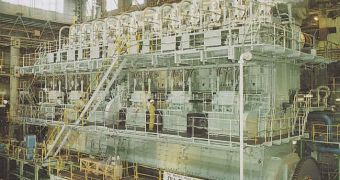What is the world's biggest internal combustion engine? Here are some clues: it's running on diesel and it's used to power the world's largest ships.
The name is W?rtsil? RTA96-C and it's the largest piston engine in the world. The turbocharged two-stroke diesel engine is manufactured by the Aioi Works in Japan and is part of Japans Diesel United Ltd engine manufacturers.
What would need such an extreme engine? Well, the world's longest, heaviest and most powerful vehicles: the world's biggest super oil tankers and large container ships.
Let's see some figures here! It's the size of a house, being 89 feet long and 44 feet wide. It doesn't have a V configuration of the cylinders, nor the most modern W one used in the latest supercars; it's a "mere" inline 12 cylinder engine.
The "slight" difference is that the diameter of each cylinder is 3 feet 2 inches (1 meter) with a stroke of 8 feet 2 inches (2.5 meters).
This engine is so heavy that I think it would have been wiser to build the ship around it. It weighs 2000 metric tons and requires the most powerful cranes to lift it and mount it on the ships.
The power output is huge, with a peak of 90,000 hp, at 100 rpm. No, it's not a typo, the engine is the most powerful and efficient low revolution engine in the world, because working at about 20 times slower than a normal 2.0 litre car engine is a major contributor to the life of the engine, which is crucial when the ship is in the middle of the ocean carrying 100,000 tons of oil.
Moving at such a slow speed is not relevant regarding the power output, but it is in terms of fuel consumption. The 14 cylinder engine for example, with a displacement of 25,480 liters (1.56 million cubic inches) burns up only 1,660 gallons of crude oil every hour, which is in fact an extraordinary fuel economy for such a monster.
This economy, plus the fact that it runs on crude oil instead of refined diesel, makes it very cost-efficient, too, since a consumption of 1,660 gallons per hour, which equals 39.5 barrels of crude oil per hour at a price of $62/barrel gives the small operating price of $2450 per hour, really small when talking about a ship that carries a cargo worth several million dollars.
Here's another interesting fact: the crankshaft alone weighs 300 tons, at a length that makes the human workers around it look really small.
For its size and power, the engine is surprisingly resistant and reliable, with a cylinder liner wear of only about 0.03 mm down for every 1000 hours of engine use.
Though it could never be mounted on a terrestrial vehicle, it's yet another impressive engineering achievement.

 14 DAY TRIAL //
14 DAY TRIAL // 
